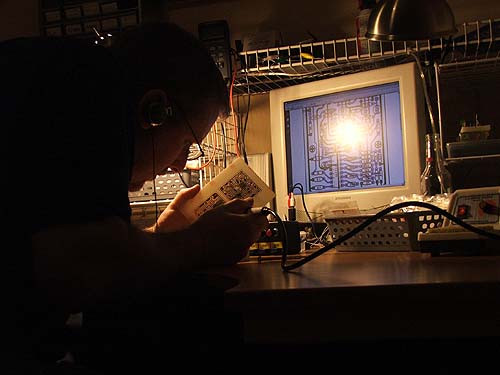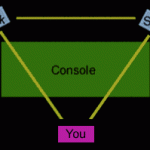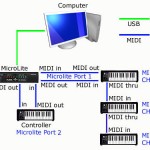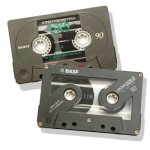
Two weekends in a row I’ve found myself standing in front of walls covered in electronic components, shopping list in hand, with a grand idea..
I’ve bought myself a new soldering iron station, set up a workbench, bought a handful of empty rack-mount boxes and melted the copper off several fiberglass boards into pretty PCB designs. This means I’m either gearing up to make some neat sound circuits or I’ve got a job with SPECTRE and hand building components which will one day be assembled into a great evil machine to blow up the moon – unless my ransom is met.
Oh wait,. the SPECTRE project IS underway but I’m not supposed to talk about it. Shhhh.
Yes, I’m working on some nifty sound circuits I’m dubbing Blot Box(es).
So what the heck is a Blot Box?
Well, let me tell you in a round-about, long winded way.
Years ago a handful of goofy kids got their kicks making free phone calls (AKA Phone Phreaks). These kids also came up with plans on making “coloured” boxes which were intended to provide various hacks to the phone system. Blue boxes were 2600 megahertz tone generators, which, when used on the Ye Olde Phone systems, allowed you to make free calls. Red Boxes generated the sound used in pay phones when particular coins were dropped in the slot. Get the idea? Personally myself, I just used the old “short the mic in the handset to the body of the pay phone with a paperclip” method – which worked until the movie War Games came out and everyone started doing it (yes, that really used to work).
As the years went on, some of the plans for Pheak boxes seemed more like flights of fancy or a fools errands. My personal favourite was The Blotto Box. The idea was simple, a Blotto Box was simply a powerful generator hooked to a main phone junction. Powered up it would gak the entire area code. Many described the effect of the Blotto Box as something that “will not work or kill you”. It if did happen to work the result would be joyfully amusing.
When I first read about the Blotto Box I giggled like a little girl. Ok, so there might be a little teenage anarchist still in me somewhere (hence my evil plan to blow up the moon..shhhh).
This brings us to circuit bending.
Circuit bending – in simple terms – is taking an existing device, like a guitar effect box or toy electronic organ, and modifying the internal circuits to emit other sounds then what was originally intended. The poor late 70’s era Speak & Spell is one of the most abused circuit bent device around. The poor thing already sounded bent from the factory.
Personally, I feel most of the Bent devices I’ve seen and heard are NOT an improvement. Most just make noisy, distorted sounds and are difficult to use as a musical instrument. That said, some are very cool. The Bent effects are my favourite. With a few simple modifications you can squeeze a bit more personality out of a factory designed effect.
This brings us to The Metatron.
I love and hate software synthesizers. I find most software synths that never leave the digital domain (IE: routing the signal directly from softsynth into the digital recording software) makes for a bland, dry sound with about the same personality as Prince Charles having a nap. I also find I don’t have the control over the sound like I do with my hardware synths – which get routed through the analogue console, out to effects, and who knows where else.
The Metatron is my answer to that. A concept to blend old and new synth designs. The heart of the device is a computer with 8 analog outs, MIDI in and out, and a keyboard (the piano kind and not the thing I’m using right now to write this). Think of this as a VCO in a modular synth – but on steroids. The analogue outputs will then route to a handful of various hardware filters and effects. From there the signal can be mutated more in a dedicated mixing surface (which can loop the signal back to other filters) and lastly out to the main console. Of course all this will be mounted in a groovy box of some sort.
If I’m going to go to all this trouble, I might as make more work for myself.
My first thought on the filters were to buy a handful of effects, perhaps bend them, and call it good. For those of you playing along at home with the Seven Graylands board game, you’ll know this was a fleeting, short-lived thought. I should just build this shit myself. Analogue filters and effects are fairly simple devices and the vast tubes of the interwebnets (not a truck!) are filled with schematics, plans, PCB artwork and designs to make such a thing if one were so inclined.
Damn it Seven! Get to the point already!
Ok. I’ve decided to group each type of effect or filter into single space rack mount boxes (the heart of the Metatron is already in a rack mount computer case). Each of these grouped filters will be called a “Blot Box” – a homage to the fantastic Blotto Box.
Hell, my Blot Boxes will either not work or kill me. If they DO happen to work, the result will be joyfully amusing. I thought the name was fitting.
Simply, each Blot Box will be a module in an expandable giant filter bank.
I’m starting the first of the Blot Boxes now. These are phase shifters, analogue delays, and simple VCF-like filters. Each Blot Box will contain several different circuits which can be used independently, in series with each other, or split to route to other Blot Boxes.
Partly this idea is based on my Washburn “Stack in a Rack” distortion box. It contains an EQ, and two distortion effects which route in series and can independently be toggled on or off. The EQ is used to get the tone, the first distortion can be used for crunchy fast attack and the last can be used for sustain – or whatever. The result of these three effects in one box makes for a distortion for any season. This is the control I want to build with the Blot Boxes – but with more then distorted sounds.
The next Blot box in the pipeline is a dual vocoder-like filter.
Most of the first Blot Box circuits will be slightly modified pre-designed effects and filters. From there I’ll get a bit more crazy and design a few of my own. When I do, I fully play to provide the schematics and PCB designs on-line.
So,. that’s what I’ve been up to.
For those of you still reading, you’re either wondering what I’m on about or trying to wrap your brain around what a device like this could do. Well, I’ll leave you with this thought.
Take a sound. Break it into several frequencies – lets say three – bass, mid and highs. Take the bass and route it to a slow flange-type effect. The mids go to a splitter/left and right – the left side to a delay which outputs to the right, the right to a delay which outputs at a slightly different time to the left. The highs are sent to a filter to change the “vowel” sound (think of a wah-wah petal that isn’t going wah-wah) which is routed to a envelope follower, and a delay which outputs in mono. In theory, that could be a pretty cool sound (or a muddy piece of shit).
Either way, what fun to play with.
Of course, pictures of the builds are forthcoming.






Recent Comments